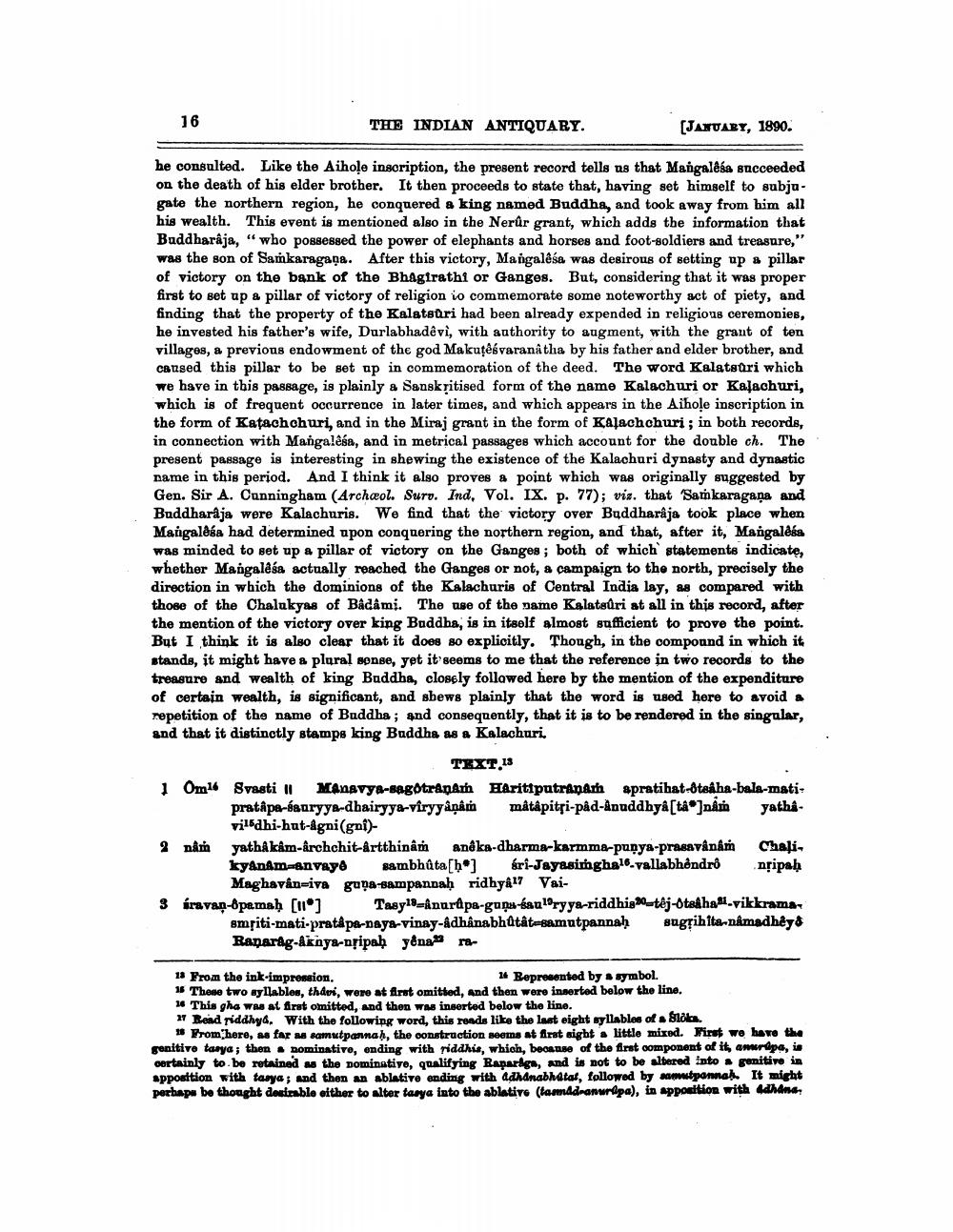________________
16
[JANUARY, 1890.
he consulted. Like the Aihole inscription, the present record tells us that Mangalêsa succeeded on the death of his elder brother. It then proceeds to state that, having set himself to subju. gate the northern region, he conquered a king named Buddha, and took away from him all his wealth. This event is mentioned also in the Nerûr grant, which adds the information that Buddharaja, "who possessed the power of elephants and horses and foot-soldiers and treasure," was the son of Samkaragana. After this victory, Mangalêsa was desirous of setting up a pillar of victory on the bank of the Bhagirathi or Ganges. But, considering that it was proper first to set up a pillar of victory of religion to commemorate some noteworthy act of piety, and finding that the property of the Kalatsuri had been already expended in religious ceremonies, he invested his father's wife, Durlabhadevi, with authority to augment, with the grant of ten villages, a previous endowment of the god Makutêévaranatha by his father and elder brother, and caused this pillar to be set up in commemoration of the deed. The word Kalatsuri which we have in this passage, is plainly a Sanskritised form of the name Kalachuri or Kalachuri, which is of frequent occurrence in later times, and which appears in the Aihole inscription in the form of Katachchuri, and in the Miraj grant in the form of Kalachchuri; in both records, in connection with Mangalêsa, and in metrical passages which account for the double ch. The present passage is interesting in shewing the existence of the Kalachuri dynasty and dynastic name in this period. And I think it also proves a point which was originally suggested by Gen. Sir A. Cunningham (Archaeol. Surv. Ind, Vol. IX. p. 77); viz. that 'Samkaragana and Buddharaja were Kalachuris. We find that the victory over Buddharaja took place when Mangalêsa had determined upon conquering the northern region, and that, after it, Mangalêsa was minded to set up a pillar of victory on the Ganges; both of which statements indicate, whether Mangalêsa actually reached the Ganges or not, a campaign to the north, precisely the direction in which the dominions of the Kalachuris of Central India lay, as compared with those of the Chalukyas of Bâdâmi. The use of the name Kalatsûri at all in this record, after the mention of the victory over king Buddha, is in itself almost sufficient to prove the point. But I think it is also clear that it does so explicitly. Though, in the compound in which it stands, it might have a plural sense, yet it seems to me that the reference in two records to the treasure and wealth of king Buddha, closely followed here by the mention of the expenditure of certain wealth, is significant, and shews plainly that the word is used here to avoid a repetition of the name of Buddha; and consequently, that it is to be rendered in the singular, and that it distinctly stamps king Buddha as a Kalachuri.
TEXT 13
1 Om Svasti ||
THE INDIAN ANTIQUARY.
Manavya-sagotranam Haritiputranam
pratipa-auryya-dhairyya-viryylg
vildhi-hut-âgni (gnî)
2 nam yathakâm-ârchchit-artthinâm
3 íravan-8pamaḥ [11]
apratihat-ôtaâha-bala-mati
mätipitri-pad-nuddhyâ[*]nis
aneka-dharma-karmma-punya-prasavânâm kyanam-anvayê sambhûta[b*] ári-Jayasinghal.vallabhondro Maghavan-iva guna-sampannah ridhyâ17 Vai
Tasy18-Anurapa-guna-sauryya-riddhis-tej-otsaha.vikkrama
smriti-mati-pratapa-naya-vinay-âdhânabhûtât-samutpannah Ranarag-aknya-nṛipaḥ yêna ra
yathâ
Chali
aripab
angrihita-nimadhy
13 From the ink-impression.
14 Represented by a symbol.
15 These two syllables, thâvi, were at first omitted, and then were inserted below the line.
16 This gha was at first omitted, and then was inserted below the line.
27 Bead riddhy, With the following word, this reads like the last eight syllables of a Sloka.
18 From here, as far as samutpannah, the construction seems at first sight a little mixed. First we have the genitive tasya; then a nominative, ending with riddhis, which, because of the first component of it, anuropa, is certainly to be retained as the nominative, qualifying Rapariga, and is not to be altered into a genitive in apposition with tasya; and then an ablative ending with adhanabhatat, followed by aamutpannah. It might perhaps be thought desirable either to alter tasya into the ablative (tammad-anur@pa), in apposition with adhana.




